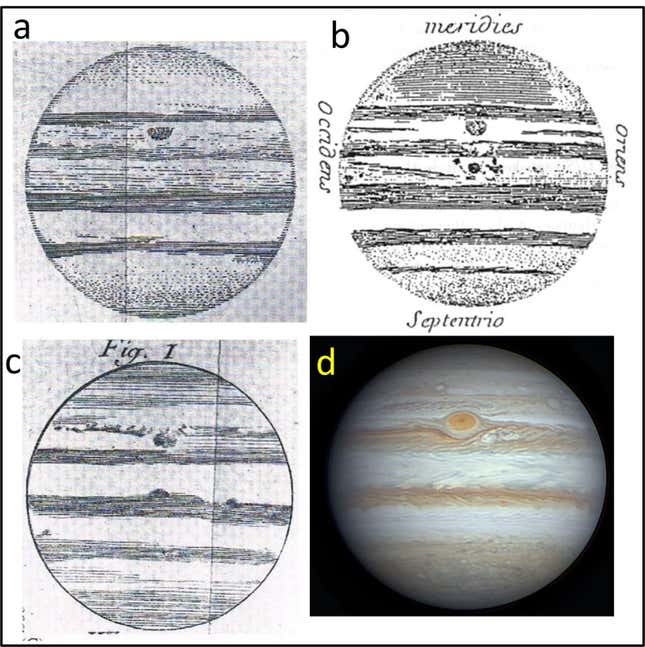In 1665, astronomer Giovanni Domenico Cassini observed a massive storm raging on Jupiter. It became known as the Great Red Spot, a swirling oval of clouds that’s almost twice as wide as Earth. New research, however, suggests that the red-hued feature spotted by Cassini is not the same storm we see today.
Suggested Reading
Hurricanes and Climate | Extreme Earth
Suggested Reading
Using historical observations of Jupiter from the 17th century, a team of scientists found that the Great Red Spot has likely persisted for a mere 190 years as opposed to 300 years of swirling winds. In a paper published in the Geophysical Research Letters, the researchers argue that the swirling storm observed by Cassini is now gone, but that a new one was born in its place years later.
After discovering the dark reddish oval on Jupiter, Cassini and other astronomers continued to observe the storm until 1713. For more than a century after, the storm hadn’t been seen. It wasn’t until 1831 when astronomers observed a similar oval shape at the same latitude. Since then, scientists have debated whether it was the same storm or a different one.
The wrongfully named ‘Permanent Spot’ likely disappeared sometime between the mid-18th and 19th centuries, according to the researchers behind the new paper. Jupiter’s Great Red Spot, on the other hand, may date back by at least 190 years.
The Great Red Spot is also much larger than its older counterpart, extending over 200 miles (350 kilometers). When it was first observed, the Great Red Spot extended over 24,200 miles (39,000 kilometers) but it has been shrinking ever since. Today, the storm stretches to 8,700 miles (14,000 kilometers) and has become more rounded in shape. Earlier observations of the Permanent Spot suggest the storm would have had to triple in size to compare to the Great Red Spot, according to the study.

The Red Spot is the largest known storm in the solar system, taking up one-sixth the diameter of Jupiter itself. Unlike hurricanes on Earth, the Great Red Spot rotates counterclockwise, which suggests that it’s a high-pressure system. The reason why the storm has been able to rage on for all those years may have to do with Jupiter’s gaseous nature. Storms on Earth tend to dissipate once they reach land, but Jupiter is made up of liquid layers instead of a solid surface.
Understanding the giant storm is not easy, with Jupiter’s clouds obstructing a clear view of the Great Red Spot in its lower atmosphere. The new study suggests the Red Spot could have formed from a gigantic superstorm, with several smaller vortices merging together. There’s still much to learn about Jupiter’s raging storms, but scientists can turn to historic observations to gather clues about the Jovian system’s mysteries.
“It has been very motivating and inspiring to turn to the notes and drawings of Jupiter and its Permanent Spot made by the great astronomer Jean Dominique Cassini, and to his articles of the second half of the 17th century describing the phenomenon,” Agustín Sánchez-Lavega, a planetary scientist at the University of the Basque Country in Bilbao, Spain, and lead author of the new paper, said in a statement. “Others before us had explored these observations, and now we have quantified the results.”
More: Astronomers Chase Shadows From Jupiter’s Mysterious Trojan Asteroids






